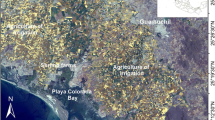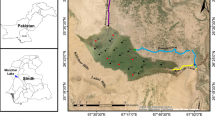Abstract
Cost-effective monitoring is necessary for all investigations of lake ecosystem responses to perturbations and long-term change. Satellite imagery offers the opportunity to extend low-cost monitoring and to examine spatial and temporal variability in water clarity data. We have developed automated procedures using Landsat imagery to estimate total suspended sediments (TSS), turbidity (TURB) in nephlometric turbidity units (NTU) and Secchi disc transparency (SDT) in 34 shallow lakes in the Waikato region, New Zealand, over a 10-year time span. Fifty-three Landsat 7 Enhanced Thematic Mapper Plus images captured between January 2000 and March 2009 were used for the analysis, six of which were captured within 24 h of physical in situ measurements for each of 10 shallow lakes. This gave 32–36 usable data points for the regressions between surface reflectance signatures and in situ measurements, which yielded r 2 values ranging from 0.67 to 0.94 for the three water clarity variables. Using these regressions, a series of Arc Macro Language scripts were developed to automate image preparation and water clarity analysis. Minimum and maximum in situ measurements corresponding to the six images were 2 and 344 mg/L for TSS, 75 and 275 NTU for TURB, and 0.05 and 3.04 m for SDT. Remotely sensed water clarity estimates showed good agreement with temporal patterns and trends in monitored lakes and we have extended water clarity datasets to previously unmonitored lakes. High spatial variability of TSS and water clarity within some lakes was apparent, highlighting the importance of localised inputs and processes affecting lake clarity. Moreover, remote sensing can give a whole lake view of water quality, which is very difficult to achieve by in situ point measurements.







Similar content being viewed by others
Explore related subjects
Discover the latest articles, news and stories from top researchers in related subjects.References
Allan, M. G., Hamilton, D. P., Hicks, B. J., & Brabyn, L. (2011). Landsat remote sensing of chlorophyll a concentrations in central North Island lakes of New Zealand. International Journal of Remote Sensing, 32(7), 2037–2055.
Allee, R. J., & Johnson, J. E. (1999). Use of satellite imagery to estimate surface chlorophyll a and Secchi disc depth of Bull Shoals Reservoir, Arkansas, USA. International Journal of Remote Sensing, 20(6), 1057–1072.
Alparslan, E., Aydöner, C., Tufekci, V., & Tüfekci, H. (2007). Water quality assessment at Ömerli Dam using remote sensing techniques. Environmental Monitoring and Assessment, 135(1–3), 391–398.
Carlson, R. E. (1977). A trophic state index for lakes. Limnology and Oceanography, 22(2), 361–369.
Chavez, P. S., Jr. (1996). Image based atmospheric corrections—revisited and improved. Photogrammetric Engineering & Remote Sensing, 62(9), 1025–1036.
Chipman, J. W., Lillesand, T. M., Schmaltz, J. E., Leale, J. E., & Nordheim, M. J. (2004). Mapping lake water clarity with Landsat images in Wisconsin, USA. Canadian Journal of Remote Sensing, 30(1), 1–7.
Collier, K., Hamilton, D., & Vant, W. (Eds.). (2010). The Waters of the Waikato: Ecology of New Zealand’s longest river. Hamilton: Environment Waikato and the Centre for Biodiversity and Ecology Research.
Curran, P. J. (1985). Principles of remote sensing. London: Longman.
Davies-Colley, R. J. (1988). Measuring water clarity with a black disk. Limnology and Oceanography, 33(4), 616–623.
Dekker, A., Vos, R., & Peters, S. (2002). Analytical algorithms for lake water TSM estimation for retrospective analyses of TM and SPOT sensor data. International Journal of Remote Sensing, 23, 15–35.
Giardino, C., Pepe, M., Brivio, P. A., Ghezzi, P., & Zilioli, E. (2001). Detecting chlorophyll, Secchi disk depth and surface temperature in a sub-alpine lake using Landsat imagery. The Science of the Total Environment, 268(1–3), 19–29.
Guan, X., Li, J., & Booty, W. G. (2011). Monitoring Lake Simcoe water clarity using Landsat-5 TM images. Water Resources Management, 25(8), 2015–2033.
Hadjimitsis, D. G., Clayton, C. R. I., & Hope, V. S. (2004). An assessment of the effectiveness of atmospheric correction algorithms through the remote sensing of some reservoirs. International Journal of Remote Sensing, 25(18), 3651–3674.
Harrington, J. A., Jr., Schiebe, F. R., & Nix, J. F. (1992). Remote sensing of Lake Chicot, Arkansas: monitoring suspended sediments, turbidity, and Secchi depth with Landsat MSS Data. Remote Sensing of Environment, 39(1), 15–27.
Hedley, J. D., Harborne, A. R., & Mumby, P. J. (2005). Technical note: simple and robust removal of sun glint for mapping shallow-water benthos. International Journal of Remote Sensing, 26(10), 2107–2112.
Irish, R. R. (2000). Landsat 7 automatic cloud cover assessment. In S. S. Shen & M. R. Descour (Eds.) Algorithms for multispectral, hyperspectral, and ultraspectral imagery IV Proceedings of SPIE 4049, 348–355.
Karakaya, N., Evrendilek, F., Aslan, G., Gungor, K., & Karakas, D. (2011). Monitoring of lake water quality along with trophic gradient using landsat data. International Journal of Environmental Science and Technology, 8(4), 817–822.
Kallio, K., Attila, J., Härmä, P., Koponen, S., Pulliainen, J., Hyytiäinen, U., et al. (2008). Landsat ETM+ images in the estimation of seasonal lake water quality in boreal river basins. Environmental Management, 42(3), 511–522.
Kirk, J. T. O. (1985). Effects of suspensoids (turbidity) on penetration of solar radiation in aquatic ecosystems. Hydrobiologia, 125(1), 195–208.
Kloiber, S. M., Brezonik, P. L., & Bauer, M. E. (2002). Application of Landsat imagery to regional-scale assessments of lake clarity. Water Research, 36(17), 4330–4340.
Kloiber, S. M., Brezonik, P. L., Olmanson, L. G., & Bauer, M. E. (2002). A procedure for regional lake water clarity assessment using Landsat multispectral data. Remote Sensing of Environment, 82(1), 38–47.
Koponen, S. (2006). Remote sensing of water quality for Finnish lakes and coastal areas. Doctoral Dissertation, Helsinki University of Technology, Helsinki.
Landsat 2010. Landsat 7 science data users handbook. http://landsathandbook.gsfc.nasa.gov/handbook.html. Accessed 22 February, 2012.
Lathrop, R. G. (1992). Landsat Thematic Mapper monitoring of turbid inland water quality. Photogrammetric Engineering & Remote Sensing, 58(4), 465–470.
Lathrop, R. G., & Lillesand, T. M. (1986). Use of Thematic Mapper data to assess water quality in Green Bay and central Lake Michigan. Photogrammetric Engineering & Remote Sensing, 52(5), 671–680.
Lillesand, T. M., Johnson, W. L., Deuell, R. L., Lindstrom, O. M., & Meisner, D. E. (1983). Use of Landsat data to predict the trophic state of Minnesota lakes. Photogrammetric Engineering & Remote Sensing, 49(2), 219–229.
McCullough, I. M., Loftin, C. S., & Sader, S. A. (2012). Combining lake and watershed characteristics with Landsat TM data for remote estimation of regional lake clarity. Remote Sensing of Environment, 123, 109–115.
Moran, M. S., Jackson, R. D., Slater, P. N., & Teillet, P. M. (1992). Evaluation of simplified procedures for retrieval of land surface reflectance factors from satellite sensor output. Remote Sensing of Environment, 41(2–3), 169–184.
Nellis, M. D., Harrington, J. A., Jr., & Wu, J. (1998). Remote sensing of temporal and spatial variations in pool size, suspended sediment, turbidity, and Secchi depth in Tuttle Creek Reservoir, Kansas: 1993. Geomorphology, 21(3–4), 281–293.
Nelson, S. A. C., Soranno, P. A., Cheruvelil, K. S., Batzli, S. A., & Skole, D. L. (2003). Regional assessment of lake water clarity using satellite remote sensing. Journal of Limnology, 62(s1), 27–32.
Novo, E. M. L. M., Steffen, C. A., & Braga, C. Z. F. (1991). Results of a laboratory experiment relating spectral reflectance to total suspended solids. Remote Sensing of Environment, 36(1), 67–72.
Olmanson, L. G., Bauer, M. E., & Brezonik, P. L. (2008). A 20-year Landsat water clarity census of Minnesota’s 10,000 lakes. Remote Sensing of Environment, 112, 4086–4097.
Preisendorfer, R. W. (1986). Secchi disk science: visual optics of natural waters. Limnology and Oceanography, 31(5), 909–926.
Pulliainen, J., Kallio, K., Eloheimo, K., Koponen, S., Servomaa, H., Hannonen, T., et al. (2001). A semi-operative approach to lake water quality retrieval from remote sensing data. The Science of the Total Environment, 268(1–3), 79–94.
Ritchie, J. C., Cooper, C. M., & Schiebe, F. R. (1990). The relationship of MSS and TM digital data with suspended sediments, chlorophyll, and temperature in Moon Lake, Mississippi. Remote Sensing of Environment, 33(2), 137–148.
Smith, D. G., Croker, G. F., & McFarlane, K. (1995). Human perception of water appearance. New Zealand Journal of Marine and Freshwater Research, 29(1), 29–43.
Wang, J.-J., Lu, X. X., Liew, S. C., & Zhou, Y. (2009). Retrieval of suspended sediment concentrations in large turbid rivers using Landsat ETM+: an example from the Yangtze River, China. Earth Surface Processes and Landforms, 34(8), 1082–1092.
Wu, G. G., De Leeuw, J., Skidmore, A. K., Prins, H. H. T., & Liu, Y. (2008). Comparison of MODIS and Landsat TM5 images for mapping tempo-spatial dynamics of Secchi disk depths in Poyang Lake National Nature Reserve, China. International Journal of Remote Sensing, 29(8), 2183–2198.
Xu, H. (2006). Modification of Normalised Difference Water Index (NDWI) to enhance open water features in remotely sensed imagery. International Journal of Remote Sensing, 27(14), 3025–3033.
Zhao, D., Cai, Y., Jiang, H., Xu, D., Zhang, W., & An, S. (2011). Estimation of water clarity in Taihu Lake and surrounding rivers using Landsat imagery. Advances in Water Resources, 34(2), 165–173.
Acknowledgments
We thank Waikato Regional Council sincerely for access to their water quality data. We also thank Kevin Collier and David Hamilton for constructive criticism of the manuscript. This study was funded by the NZ Ministry of Business, Innovation and Employment contract UOWX0505.
Author information
Authors and Affiliations
Corresponding author
Appendices
Appendix 1
Table 7.
Appendix 2
Table 8.
Rights and permissions
About this article
Cite this article
Hicks, B.J., Stichbury, G.A., Brabyn, L.K. et al. Hindcasting water clarity from Landsat satellite images of unmonitored shallow lakes in the Waikato region, New Zealand. Environ Monit Assess 185, 7245–7261 (2013). https://doi.org/10.1007/s10661-013-3098-2
Received:
Accepted:
Published:
Issue Date:
DOI: https://doi.org/10.1007/s10661-013-3098-2




